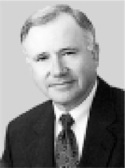Notice of 2002 Annual Meeting • Proxy Statement
American Electric Power
Company, Inc.
1 Riverside Plaza
Columbus, OH 43215
![]()
March 21, 2002
Dear Shareholder:
This year’s annual meeting of shareholders will be held at The Ohio State University’s Fawcett Center, 2400 Olentangy River Road, Columbus, Ohio, on Tuesday, April 23, 2002, at 9:30 a.m.
Your Board of Directors and I cordially invite you to attend.
E. Linn Draper, Jr.
Chairman of the Board,
President and
Chief Executive Officer
During the course of the meeting there will be the usual time for discussion of the items on the agenda and for questions regarding AEP’s affairs. Directors and officers will be available to talk individually with shareholders before and after the meeting.
Your vote is very important. Shareholders of record can vote in any one of the following three ways:
- By Mail — Fill in, sign and date your enclosed proxy card and return it promptly in the enclosed postage-paid envelope.
- By Telephone — Call the toll-free telephone number on your proxy card to vote by phone.
- Via Internet — Visit the web site on your proxy card to vote via the Internet.
If your shares are held in the name of a bank, broker or other holder of record, you will receive instructions from the holder of record that you must follow in order for you to vote your shares.
If you plan to attend the meeting and are a shareholder of record, please mark the “Annual Meeting” box on your proxy card or follow the prompts when you vote if you are voting by telephone or Internet. An admission ticket is included with the proxy card for each shareholder of record. However, if your shares are not registered in your own name, please advise the shareholder of record (your bank, broker, etc.) that you wish to attend. That firm must provide you with evidence of your ownership on March 4 which will enable you to gain admittance to the meeting.
Sincerely,

NOTICE OF 2002 ANNUAL MEETING
American Electric Power Company, Inc.
1 Riverside Plaza
Columbus, Ohio 43215
|
TIME |
9:30 a.m. on Tuesday, April 23, 2002 |
|
PLACE |
Fawcett Center |
|
|
The Ohio State University |
|
|
2400 Olentangy River Road |
|
|
Columbus, Ohio |
|
ITEMS OF BUSINESS |
(1) To elect 13 directors to hold office until the next annual meeting and until their successors are duly elected. |
|
|
(2) To approve the firm of Deloitte & Touche llp as independent auditors for the year 2002. |
|
|
(3) To consider and act on such other matters, including the shareholder proposal described on pages 12 and 13 of the accompanying proxy statement, as may properly come before the meeting. |
|
RECORD DATE |
Only shareholders of record at the close of business on March 4, 2002, are entitled to notice of and to vote at the meeting or any adjournment thereof. |
|
ANNUAL REPORT |
Appendix A to this proxy statement has AEP’s audited financial statements and management’s discussion and analysis of results of operations and financial condition. AEP’s Summary Report to Shareholders contains our chairman’s letter to shareholders, condensed financial statements, a summary discussion of results of operations and financial condition, and an independent auditors’ report. |
|
PROXY VOTING |
It is important that your shares be represented and voted at the meeting. Please vote in one of these ways: |
|
|
(1) MARK, SIGN, DATE AND PROMPTLY RETURN the enclosed proxy card in the postage-paid envelope. |
|
|
(2) USE THE TOLL-FREE TELEPHONE NUMBER shown on the proxy card. |
|
|
(3) VISIT THE WEB SITE noted on your proxy card to vote via the Internet. |
|
|
Any proxy may be revoked at any time prior to its exercise at the meeting. |
|
March 21, 2002 |
Susan Tomasky |
Our annual meeting of shareholders also will be webcast on our web site at www.aep.com at 9:30 a.m. on April 23, 2002.
Proxy Statement
March 21, 2002
Proxy and Voting Information
This proxy statement and the accompanying proxy card are to be mailed to shareholders, commencing on or about March 21, 2002, in connection with the solicitation of proxies by the Board of Directors of American Electric Power Company, Inc., 1 Riverside Plaza, Columbus, Ohio 43215, for the annual meeting of shareholders to be held on April 23, 2002 in Columbus, Ohio.
Who Can Vote. Only the holders of shares of Common Stock at the close of business on March 4, 2002 are entitled to vote at the meeting. Each such holder has one vote for each share held on all matters to come before the meeting. On that date, there were 322,387,649 shares of AEP Common Stock, $6.50 par value, outstanding.
How You Can Vote. Shareholders of record can give proxies by (i) mailing their signed proxy cards, (ii) calling a toll-free telephone number or (iii) using the Internet. The telephone and Internet voting procedures are designed to authenticate shareholders’ identities, to allow shareholders to give their voting instructions and to confirm that shareholders’ instructions have been properly recorded. Instructions for shareholders of record who wish to use the telephone or Internet voting procedures are set forth on the enclosed proxy card.
When proxies are returned, the shares represented thereby will be voted by the persons named on the proxy card or by their substitutes in accordance with shareholders’ directions. If a proxy card is signed and returned without choices marked, it will be voted for the nominees for directors listed on the card and as recommended by the Board of Directors with respect to other matters. The proxies of shareholders who are participants in the Dividend Reinvestment and Stock Purchase Plan include both the shares registered in their names and the whole shares held in their Plan accounts on March 4, 2002.
Revocation of Proxies. A shareholder giving a proxy may revoke it at any time before it is exercised at the meeting by giving notice of its revocation to the Company, by executing another proxy dated after the proxy to be revoked, or by attending the meeting and voting in person.
How Votes are Counted. Under New York law, abstentions and broker non-votes do not count in the determination of voting results and have no effect on the vote. The determination by the shareholders of approval of the auditors and the shareholder proposal is based on votes “for” and “against” — with abstentions and broker non-votes not counted as “against” votes but counted in the determination of a quorum. Unvoted shares are termed “non-votes” when a nominee holding shares for beneficial owners may not have received instructions from the beneficial owner and may not have exercised discretionary voting power on certain matters, but with respect to other matters may have voted pursuant to discretionary authority or beneficial owner instructions.
Your Vote is Confidential. It is AEP’s policy that shareholders be provided privacy in voting. All proxies, voting instructions and ballots, which identify shareholders, are held confidential, except as may be necessary to meet any applicable legal requirements. We direct proxies to an independent third-party tabulator, who receives, inspects, and tabulates them. Voted proxies and ballots are not seen by nor reported to AEP except (i) in aggregate number or to determine if (rather than how) a shareholder has voted, (ii) in cases where shareholders write comments on their proxy cards, or (iii) in a contested proxy solicitation.
Multiple Copies of Annual Report or Proxy Statement to Shareholders. Securities and Exchange Commission rules provide that more than one annual report or proxy statement need not be sent to the same address. This practice is commonly called “householding” and is intended to eliminate duplicate mailings of shareholder documents. Mailing of your annual report or proxy statement is being householded indefinitely unless you instruct us otherwise. If more than one annual report or proxy statement is being sent to your address, at your request, mailing of the duplicate copy to the account you select will be discontinued. If you wish to resume or discontinue receiving separate annual reports or proxy statements at the same address, you may call our transfer agent, EquiServe Trust Company, N.A., at 800-328-6955 or write to them at P.O. Box 2500, Jersey City, NJ 07303-2500. The change will be effective 30 days after receipt. We will deliver promptly upon oral or written request a separate copy of the annual report or proxy statement to a shareholder at a shared address. To receive a separate copy of the annual report or proxy statement, contact AEP Shareholder Direct at 800-551-1AEP(1237) or write to AEP, attention: Financial Reporting, at 1 Riverside Plaza, Columbus, OH 43215.
1. Election of Directors
Thirteen directors are to be elected by a plurality of the votes cast at the meeting to hold office until the next annual meeting and until their successors have been elected. AEP’s By-Laws provide that the number of directors of AEP shall be such number, not less than 9 nor more than 17, as shall be determined from time to time by resolution of AEP’s Board of Directors.
On January 23, 2002, the Board of Directors adopted a resolution reducing the number of directors by one, effective on the date of the annual meeting. Mr. James L. Powell, a director, will be retiring from the Board and not standing for reelection.
The 13 nominees named on pages 3-7 were selected by the Board of Directors on the recommendation of the Committee on Directors and Corporate Governance of the Board. The proxies named on the proxy card or their substitutes will vote for the Board’s nominees, unless instructed otherwise. Shareholders may withhold authority to vote for any or all of such nominees on the proxy card. All of the Board’s nominees were elected by the shareholders at the 2001 annual meeting. It is not expected that any of the nominees will be unable to stand for election or be unable to serve if elected. In the event that a vacancy in the slate of nominees should occur before the meeting, the proxies may be voted for another person nominated by the Board of Directors or the number of directors may be reduced accordingly.
Cumulative Voting. Shareholders have the right to vote cumulatively for the election of directors. This means that in the voting at the meeting each shareholder, or his proxy, may multiply the number of his shares by the number of directors to be elected and then cast the resulting total number of votes for a single nominee, or distribute such votes on the ballot among any two or more nominees as desired. The proxies designated by the Board of Directors will not cumulate the votes of the shares they represent.
Biographical Information. The following brief biographies of the nominees include their principal occupations, ages on the date of this statement, accounts of their business experience and names of certain companies of which they are directors. Data with respect to the number of shares of AEP’s Common Stock, options exercisable within 60 days and stock-based units beneficially owned by each of them appears on page 24.
Nominees For Director
 |
E. R. Brooks Retired Chairman and Chief Executive Officer, Central and South West Corporation, Granbury, Texas Age 64 Director since 2000 |
Received his B.S. (electrical engineering) from Texas Tech University in 1961. Chairman and chief executive officer of Central and South West Corporation (February 1991-June 2000). Served as CSW’s president from February 1991 to July 1997. A director of Hubbell, Inc. A trustee of Baylor Health Care Center, Dallas, Texas, Hardin-Simmons University, Abilene, Texas, and Texas Tech University, Lubbock, Texas. |
|
|
||
 |
Donald M. Carlton Retired President and Chief xecutive Officer, Radian International LLC, Austin, Texas Age 64 Director since 2000
|
Received his B.A. from the University of St. Thomas in Houston in 1958 and Ph.D. (organic chemistry) from the University of Texas at Austin in 1962. President and chairman of Radian Corporation, an engineering and technology firm (1969-1995). President and chief executive officer of Radian International LLC (1996-1998). A director of National Instruments Corporation and Valero Energy Corporation and trustee of 26 mutual funds in the Smith Barney/ Citi fund complex. |
|
|
||
 |
John P. DesBarres Investor/Consultant, Park City, Utah Age 62 Director since 1997 |
Received an associate degree in electrical engineering from Worcester Junior College in 1960 and completed the Harvard Business School Program for Management Development in 1975 and the Massachusetts Institute of Technology Sloan School Senior Executive Program in 1984. Joined Sun Company (petroleum and natural gas) in 1963, holding various positions until 1979, when he was elected president of Sun Pipe Line Company (1979-1988) (crude oil/products). Chairman, president and chief executive officer of Sante Fe Pacific Pipelines, Inc. (1988-1991) (petroleum products pipeline). President and chief executive officer (1991-1995) and chairman (1992-1995) of Transco Energy Company (natural gas). A director of Texas Eastern Products Pipeline Company, which is the general partner of TEPPCO Partners, L.P., and Penn Virginia GP, LLC, an indirect wholly-owned subsidiary of Penn Virginia Corporation and the general partner of Penn Virginia Resource Partners, L.P. |
|
|
||
 |
E. Linn Draper, Jr. Chairman, President and Chief Executive Officer of AEP and AEP Service Corporation; Chairman and Chief Executive Officer of other major AEP subsidiaries Age 60 Director since 1992
|
Received his B.A. and B.S. (chemical engineering) degrees from Rice University in 1964 and 1965, respectively, and Ph.D. (nuclear engineering) in 1970 from Cornell University. Joined Gulf States Utilities Company, an unaffiliated electric utility, in 1979. Chairman of the board, president and chief executive officer of Gulf States (1987-1992). Elected president of AEP and president and chief operating officer of AEP Service Corporation in March 1992 and chairman of the board and chief executive officer of AEP and all of its major subsidiaries in April 1993. A director of BCP Management, Inc., which is the general partner of Borden Chemicals and Plastics L.P. |
|
|
||
 |
Robert W. Fri Visiting Scholar, Resources for the Future, Washington, D.C. Age 66 Director since 1995
|
Holds a B.A. from Rice University and an M.B.A. from Harvard Business School. Associated with McKinsey & Company, Inc., management consulting firm, from 1963 to 1971 and again from 1973 to 1975, being elected a principal in the firm in 1968. From 1971 to 1973, served as first Deputy Administrator of the Environmental Protection Agency, becoming Acting Administrator in 1973. Was first Deputy and then Acting Administrator of the Energy Research and Development Administration from 1975 to 1977. From 1978 to 1986 was President of Energy Transition Corporation. President and director of Resources for the Future (non-profit research organization) from 1986 to 1995 and became senior fellow emeritus in 1996. Director, National Museum of Natural History (Smithsonian Institution) (1996-2001). Assumed his present position with Resources for the Future in 2001. |
|
|
||
 |
William R. Howell Chairman Emeritus, J. C. Penney Company, Inc., Dallas, Texas Age 66 Director since 2000
|
Received his B.B.A. from the University of Oklahoma in 1958. Joined J.C. Penney Company (major retailer) in 1958 and held various managerial positions. Chairman of the board of J. C. Penney Company from 1983 to January 1997 and also chief executive officer from 1983 to January 1996. Chairman emeritus of J. C. Penney Company (1997 -present). A director of Bankers Trust, Exxon Mobil Corporation, Halliburton Company, Pfizer Inc., Viseon, Inc. and The Williams Companies, Inc. |
|
|
||
 |
Lester A. Hudson, Jr. Professor of Business Strategy, Clemson University, Greenville, South Carolina Age 62 Director since 1987
|
Received a B.A. from Furman University in 1961, an M.B.A. from the University of South Carolina in 1965 and Ph.D. (industrial management) from Clemson University in 1997. Joined Dan River Inc. (textile fabric manufacturer) in 1970 and was elected president and chief operating officer in 1981 and chief executive officer in 1987. Resigned from Dan River in 1990. Joined WundaWeve Carpets, Inc. (carpet manufacturer) as chairman, president and chief executive officer in 1990. Chairman of WundaWeve in 1991. Vice chairman of WundaWeve (1993-1995). Chairman, H&E Associates (investment firm), 1995-1998. Assumed his present position with Clemson University in 1998. A director of American National Bankshares Inc. and Greenville Hospital System Foundation and trustee of The Sirrine Foundation and Furman University Advisory Council. |
|
|
||
 |
Leonard J. Kujawa International Energy Consultant, Atlanta, Georgia Age 69 Director since 1997 |
Received his B.B.A. in 1954 and M.B.A. in 1955 from the University of Michigan. Joined Arthur Andersen LLP (accounting and consulting firm) in 1957 and became a partner in 1968, specializing in the electric and telecommunications industries. Worldwide Director Energy and Telecommunications (1985-1995). Retired in 1995. International energy consultant to his former firm and other global companies. A director of Schweitzer-Mauduit International, Inc. |
|
|
||
 |
Richard L. Sandor Chairman and Chief Executive Officer, Environmental Financial Products LLC, Chicago, Illinois Age 60 Director since 2000 |
Received his B.A. from City University of New York, Brooklyn College, and Ph.D. (economics) from the University of Minnesota. Chairman and chief executive officer of Environmental Financial Products LLC (develops and trades in new environmental, financial and commodity markets) since March 1993. Second vice chairman of the Chicago Board of Trade (1997-1998). A director of Nasdaq LIFFE, LLC and Nextera Enterprises, Inc. |
|
|
||
 |
Thomas V. Shockley, III Vice Chairman of AEP; Vice Chairman and Chief Operating Officer, AEP Service Corporation Age 56 Director since 2000 |
Received his B.S. (electrical engineering) from Texas A&I University in 1967 and M.S. (electrical engineering) from the University of Texas at Austin in 1969. Executive vice president (1990-1997) and president and chief operating officer (1997-2000) of Central and South West Corporation. Elected vice chairman of AEP and of AEP Service Corporation in 2000 and chief operating officer of AEP Service Corporation in October 2001. |
|
|
||
 |
Donald G. Smith Chairman of the Board, President, Chief Executive Officer and Treasurer of Roanoke Electric Steel Corporation, Roanoke, Virginia Age 66 Director since 1994 |
Joined Roanoke Electric Steel Corporation (steel manufacturer) in 1957. Held various positions with Roanoke Electric Steel before being named president and treasurer in 1985, chief executive officer in 1986 and chairman of the board in 1989. |
|
|
||
 |
Linda Gillespie Stuntz Partner, Stuntz, Davis & Staffier, P.C., attorneys, Washington, D.C. Age 47 Director since 1993 |
Holds an A.B. from Wittenberg University (1976) and J.D. from Harvard Law School (1979). Private practice of law (1979-1981). U.S. House of Representatives, Committee on Energy and Commerce: Associate Minority Counsel, Subcommittee on Fossil and Synthetic Fuels (1981-1986) and Minority Counsel and Staff Director (1986-1987). Private practice of law (1987-1989). U.S. Department of Energy (1989-1993): Acting Deputy Secretary (January 1992-July 1992) and Deputy Secretary (July 1992-January 1993). Returned to the private practice of law in March 1993. A director of Schlumberger Limited and the Electricity Innovation Institute. |
|
|
||
 |
Kathryn D. Sullivan |
Received her B.S. from the University of California and Ph.D. from Dalhousie University. NASA space shuttle astronaut (1978-1993). Chief Scientist at the National Oceanic and Atmospheric Administration (1993-1996). Became president and chief executive officer of Columbus’ science museum COSI (Center of Science & Industry) in 1996. U.S. Naval Reserve Officer. A director of Abercrombie & Fitch Co. |
|
|
||
Dr. Draper and Mr. Shockley are directors of certain subsidiaries of AEP with one or more classes of publicly held preferred stock or debt securities and other subsidiaries of AEP.
Related Transactions
Dr. Draper’s son is a partner in the law firm of Winston & Strawn, which AEP retained during 2001 for matters primarily relating to the license renewal for the Cook Nuclear Plant. Dr. Draper’s son has not been involved with any AEP legal matters.
AEP’s Board of Directors and Committees
Under New York law, AEP is managed under the direction of the Board of Directors. The Board establishes broad corporate policies and authorizes various types of transactions, but it is not involved in day-to-day operational details. During 2001, the Board held eight regular and one special meeting.
The Board has seven standing committees and the table below provides membership and meeting information for each of them. The functions of the committees are described in the paragraphs following the table.
|
DIRECTOR |
BOARD COMMITTEES | ||||||
| Audit | Directors and Corporate Governance |
Policy |
Executive |
Finance |
Human Resources |
Nuclear Oversight |
|
|
Mr. Brooks |
X | X | X | ||||
|
Dr. Carlton |
X (Chair) | X | X | X | |||
|
Mr. DesBarres |
X | X | X (Chair) | X | |||
|
Dr. Draper |
X (Chair) | ||||||
|
Mr. Fri |
X (Chair) | X | X | ||||
|
Mr. Howell |
X | X | X | ||||
|
Dr. Hudson |
X | X (Chair) | X | ||||
|
Mr. Kujawa |
X | X | X | ||||
|
Mr. Powell |
X | X | X | ||||
|
Dr. Sandor |
X | X | X | ||||
|
Mr. Shockley |
|||||||
|
Mr. Smith |
X | X | X | ||||
|
Ms. Stuntz |
X | X | X | X (Chair) | |||
|
Dr. Sullivan |
X | X | X (Chair) | ||||
|
2001 Meetings |
9 | 2 | 3 | 0 | 5 | 5 | 4 |
During 2001, except for Mr. Brooks, no incumbent director attended fewer than 75% of the aggregate of the total number of meetings of the Board of Directors and the total number of meetings held by all committees on which he or she served.
The Audit Committee oversees, and reports to the Board concerning, the general policies and practices of AEP and its subsidiaries with respect to accounting, financial reporting, and internal auditing and financial controls. It also maintains a direct exchange of information between the Board and AEP’s independent accountants and reviews possible conflict of interest situations involving directors.
The Board of Directors has adopted a written charter for the Audit Committee.
The members of the Audit Committee are independent as defined by the rules of the New York Stock Exchange.
The Committee on Directors and Corporate Governance is responsible for:
- Recommending the size of the Board within the boundaries imposed by the By-Laws.
- Recommending selection criteria for nominees for election or appointment to the Board.
- Conducting independent searches for qualified nominees and screening the qualifications of candidates recommended by others.
- Recommending to the Board for its consideration one or more nominees for appointment to fill vacancies on the Board as they occur and the slate of nominees for election at the annual meeting.
- Reviewing and making recommendations to the Board with respect to the compensation of directors and corporate governance.
The Committee on Directors and Corporate Governance will consider shareholder recommendations of candidates to be nominated as directors of the Company. All such recommendations must be in writing and addressed to the Secretary of the Company. By accepting a shareholder recommendation for consideration, the Committee on Directors and Corporate Governance does not undertake to adopt or take any other action concerning the recommendation, or to give the proponent its reasons for not doing so.
The Policy Committee is responsible for examining AEP’s policies on major public issues affecting the AEP System, including environmental, industry change and other matters, as well as established System policies which affect the relationship of AEP and its subsidiaries to their service areas and the general public; for reporting periodically and on request to the Board and providing recommendations to the Board on such policy matters; and for counseling AEP management on any such policy matters presented to the Committee for consideration and study.
The Executive Committee is empowered to exercise all the authority of the Board of Directors, subject to certain limitations prescribed in the By-Laws, during the intervals between meetings of the Board. Meetings of the Executive Committee are convened only in extraordinary circumstances.
The Finance Committee monitors and reports to the Board with respect to the capital requirements and financing plans and programs of AEP and its subsidiaries including, among other things, reviewing and making recommendations as it considers appropriate concerning the short and long-term financing plans and programs of AEP and its subsidiaries.
The Human Resources Committee is responsible for:
- Reviewing executive compensation policies and plans and, as appropriate, recommending changes to the Board.
- Reviewing salaries and other compensation and benefits paid by AEP and its subsidiaries to Board members who are AEP officers or employees of any of its subsidiaries, and for recommending to the Board for approval the amount of salary and other compensation and benefits to be paid or accrued by AEP and/or any of its subsidiaries during the ensuing year to each such person.
- Reviewing and approving compensation and benefits for the AEP Service Corporation officers who hold the position of Senior Vice President or higher office.
- Evaluating AEP’s hiring, development, promotional and succession planning practices for those management positions described in (2) and (3) above and recommending changes as appropriate.
- Reviewing AEP’s performance with respect to work force diversity and compliance with equal employment opportunity laws.
The Nuclear Oversight Committee is responsible for overseeing and reporting to the Board with respect to the management and operation of AEP’s nuclear generation.
Directors Compensation and Stock Ownership Guidelines
Annual Retainers and Meeting Fees. Directors who are officers of AEP or employees of any of its subsidiaries do not receive any compensation, other than their regular salaries and the accident insurance coverage described below, for attending meetings of AEP’s Board of Directors. The other members of the Board receive an annual retainer of $35,000 for their services, an additional annual retainer of $5,000 for each Committee that they chair, a fee of $1,200 for each meeting of the Board and of any Committee that they attend (except a meeting of the Executive Committee held on the same day as a Board meeting), and a fee of $1,200 per day for any inspection trip or conference.
Deferred Compensation and Stock Plan. The Deferred Compensation and Stock Plan for Non-Employee Directors permits non-employee directors to choose to receive up to 100 percent of their annual Board retainer in shares of AEP Common Stock and/or units that are equivalent in value to shares of Common Stock (“Stock Units”), deferring receipt by the non-employee director until termination of service or for a period that results in payment commencing not later than five years thereafter. AEP Common Stock is distributed and/or Stock Units are credited to directors, as the case may be, when the retainer is payable, and are based on the closing price of the Common Stock on the payment date. Amounts equivalent to cash dividends on the Stock Units accrue as additional Stock Units. Payment of Stock Units to a director from deferrals of the retainer and dividend credits is made in cash or AEP Common Stock, or a combination of both, as elected by the director.
Stock Unit Accumulation Plan. The Stock Unit Accumulation Plan for Non-Employee Directors annually awards 1,200 Stock Units to each non-employee director as of the first day of the month in which the non-employee director becomes a member of the Board. Amounts equivalent to cash dividends on the Stock Units accrue as additional Stock Units. Stock Units are paid to the director in cash upon termination of service unless the director has elected to defer payment for a period that results in payment commencing not later than five years thereafter.
Insurance. AEP maintains a group 24-hour accident insurance policy to provide a $1,000,000 accidental death benefit for each director. The current policy, effective September 1, 2001 through September 1, 2004, has a premium of $31,050. In addition, AEP pays each director (excluding officers of AEP or employees of any of its subsidiaries) an amount to provide for the federal and state income taxes incurred in connection with the maintenance of this coverage ($630 for 2001).
Central and South West Corporation Programs. Mr. Powell, as a former CSW director, is enrolled in a medical and dental program formerly offered by CSW to its non-employee directors. AEP is continuing this program, pursuant to the terms of the merger with CSW, for those CSW directors who had previously elected to participate. Mr. Powell pays a portion of the cost of his coverage. Upon Mr. Powell’s termination of service with the Board, he will be eligible to receive retiree medical and dental benefits coverage.
AEP is also continuing a memorial gift program for former CSW directors and executive officers who had been previously participating in this program. The six former CSW directors who are members of AEP’s Board are participants. Under this program, AEP makes donations in a director’s name to up to three charitable organizations in an aggregate amount of up to $500,000, payable by AEP upon such person’s death. AEP maintains corporate-owned life insurance policies to fund the program. The annual premiums paid by AEP are based on pooled risks and averaged $15,100 per participant for 2001.
Stock Ownership Guidelines. AEP’s Board of Directors considers stock ownership in AEP by management to be of great importance. Such ownership enhances management’s commitment to the future of AEP and further aligns management’s interests with those of AEP’s shareholders. In keeping with this philosophy, the Board has adopted minimum stock ownership guidelines for non-employee directors. The target for each non-employee director is 2,000 shares of AEP Common Stock and/or Stock Units, with such ownership to be acquired by the end of the third year of service.
For further information as to the guidelines for AEP’s executive officers, see the Board Human Resources Committee Report on Executive Compensation below under the caption Stock Ownership Guidelines.
Insurance
The directors and officers of AEP and its subsidiaries are insured, subject to certain exclusions, against losses resulting from any claim or claims made against them while acting in their capacities as directors and officers. The American Electric Power System companies are also insured, subject to certain exclusions and deductibles, to the extent that they have indemnified their directors and officers for any such losses. Such insurance, effective January 1, 2002 through December 31, 2002, is provided by: Associated Electric & Gas Insurance Services, Energy Insurance Mutual, Clarendon National Insurance Company, Great American Insurance Company, Zurich American Insurance Company, Zurich Specialties London (UK) Ltd., National Union Fire Insurance Company of Pittsburgh, PA, Liberty Mutual Insurance Company, Federal Insurance Company, Starr Excess International, Royal Insurance Company of America, Gulf Insurance Company, Starr Excess Casualty Insurance Limited, Oil Casualty Insurance Limited, XL Insurance, Ltd., XL Specialty Insurance Company, SR International Business Insurance Company Ltd., and Lumbermens Mutual Casualty Company. The total cost of this insurance is $2,690,766.
Fiduciary liability insurance provides coverage for AEP System companies, their directors and officers, and any employee deemed to be a fiduciary or trustee, for breach of fiduciary responsibility, obligation, or duties as imposed under the Employee Retirement Income Security Act of 1974. This coverage, provided by Associated Electric & Gas Insurance Services, The Federal Insurance Company, and Zurich American Insurance Company, was renewed, effective July 1, 2000 through June 30, 2003, for a cost of $355,350.
2. Approval of Auditors
On the recommendation of the Audit Committee, the Board of Directors has appointed the accounting firm of Deloitte & Touche llp as independent auditors of AEP for the year 2002, subject to approval by the shareholders at the annual meeting. Deloitte & Touche llp is considered to be the firm best qualified to perform this important function because of its ability and the familiarity of its personnel with AEP’s affairs. It and predecessor firms have been AEP’s auditors since 1911.
Representatives of Deloitte & Touche llp will be present at the meeting and will have an opportunity to make a statement if they desire to do so. They also will be available to answer appropriate questions.
Aggregate fees billed to AEP and its consolidated subsidiaries for services rendered by Deloitte & Touche llp and its global affiliates for the year ended December 31, 2001, were:
|
Audit Fees |
$5,184,000 | |
|
Financial Information Systems Design and |
100,000 | |
|
All Other Fees |
||
|
Audit-related: |
||
|
Financings, comfort letters and consents |
$461,000 | |
|
Employee benefit and statutory audits |
710,000 | |
|
Due diligence accounting and related services |
603,000 | |
|
Other audit-related |
455,000 | 2,229,000 |
|
|
||
|
Tax: |
||
|
Global tax planning and consultation |
4,282,000 | |
|
Tax return compliance and related services |
677,000 | 4,959,000 |
|
|
||
|
Other |
354,000 | |
|
|
||
|
Total |
$12,826,000 | |
|
|
The Audit Committee has considered whether the provision of services other than audit services by Deloitte & Touche llp and its global affiliates is compatible with maintaining that firm’s independence and the Committee believes that this provision of services is compatible with maintaining Deloitte & Touche llp’s independence.
Vote Required. Approval of this proposal requires the affirmative vote of holders of a majority of the shares present in person or by proxy at the meeting.
Your Board of Directors recommends a vote FOR approval of Deloitte & Touche llp as independent auditors for 2002.
Audit Committee Report
The Audit Committee reviews AEP’s financial reporting process on behalf of the Board of Directors. Management has the primary responsibility for the financial statements and the reporting process, including the system of internal controls.
In this context, the Committee has met and held discussions with management and the independent auditors. Management represented to the Committee that AEP’s consolidated financial statements were prepared in accordance with generally accepted accounting principles, and the Committee has reviewed and discussed the consolidated financial statements with management and the independent auditors. The Committee discussed with the independent auditors matters required to be discussed by Statement on Auditing Standards No. 61, as amended (Communication With Audit Committees).
In addition, the Committee has discussed with the independent auditors, the auditor’s independence from AEP and its management, including the matters in the written disclosures required by the Independence Standards Board Standard No. 1 (Independence Discussions With Audit Committees).
In reliance on the reviews and discussions referred to above, the Committee recommended to the Board of Directors, and the Board has approved, that the audited financial statements be included in AEP’s Annual Report on Form 10-K for the year ended December 31, 2001, for filing with the Securities and Exchange Commission.
|
Audit Committee Members |
|
|
Donald M. Carlton, Chair |
James L. Powell |
|
Lester A. Hudson, Jr. |
Kathryn D. Sullivan |
3. Shareholder Proposal
Mr. Ronald Marsico, 935 Loch Ness Avenue, Worthington, OH 43085, who states that he is the record owner of 2,897 shares of Common Stock, has notified AEP that he intends to present the following proposal for consideration and action at the meeting:
“Shareholder Proposal — Recommended by Ronald Marsico
The maximum total amount of service by any Director of the American Electric Power Company, Inc. should be limited to ten terms of office and this limit should also apply retroactively to existing Directors. This limitation should apply to nominees for director at meetings subsequent to the 2002 Annual Meeting.
Supporting Reasons Based On Ronald Marsico’s Analyses And Opinions
Term Limits for AEP Directors is a reasonable means to help protect shareholders against the complacency that may result from a lack of accountability that can be inherent in the ‘buddy-system’ of re-nominating and re-electing the same Directors year after year. My long-time observation of AEP proxy ballots notes how often the nominees simply re-nominate each other year after year.
The fact that the President of the U.S., virtually all governors, mayors, and many other officials are limited to two four-year terms speaks volumes about the benefits of not allowing top officials to become too comfortable in their positions. In my opinion, this rationale certainly applies when a group of Directors has exhibited less than solid performances over a period of several years.
I have written to the Chairman and various Directors a number of times in the last several years with my serious concerns about questionable decisions and actions of the Board which I believe are at the root of the Company’s lackluster financial performance. In these letters, I came close to predicting several of the subsequent costly results which (in my opinion) occurred because of some of the Board’s flawed policies and decisions.
Why can’t our Directors use their talents and resources proactively to save shareholders massive amounts of money and stock value? Can it be that long-duration tenure has led to complacency and less than aggressive oversight?
I urge my fellow shareholders to consider my opinions and this proposal and vote for it during the year 2002 voting period prior to the 2002 Annual Shareholder Meeting so that the Company has the benefit of your guidance!”
Directors’ Recommendation
Your Board of Directors recommends a vote AGAINST the preceding shareholder proposal for the following reasons:
AEP believes that its current practices and those of the Committee on Directors and Corporate Governance concerning the nomination and service of directors ensure a balanced Board composed of competent and distinguished individuals with diverse backgrounds, knowledge, and experience. Setting arbitrary term limits for directors, who, in any case, are elected each year, would be counter-productive, likely diminish Board effectiveness, and not be in the best interests of the Board, AEP or the shareholders.
The tenure of directors is not guaranteed. The shareholders, following formal nomination by the Board’s Committee on Directors and Corporate Governance, elect AEP’s directors annually. The Board of Directors view mandatory term limits as incompatible with the rights currently accorded to the shareholders to choose the best qualified individuals to serve as members of their Board on an annual basis without arbitrary limits on who may serve.
The proposal does not draw a distinction between term limits for non-employee (outside) versus employee (inside) directors. Limiting inside directors to a ten-year term could force unwarranted turnover in the management of AEP and be highly disruptive to the Company’s business.
Quality leadership is the lifeblood of a company. Imposing term limits for directors could result in AEP losing the services of directors who have developed a great deal of insight and perspective about AEP’s operations and, therefore, would be in a position to make their most valuable contributions to AEP’s business. Continuity of service permits directors to acquire a depth of knowledge concerning AEP that enhances their capability. Term limits mean the untimely exit of effective directors and make it more difficult to recruit qualified candidates.
To provide further that fresh ideas and viewpoints are available to the Board as necessary, AEP’s retirement policy provides that a director is generally ineligible for reelection for a term commencing subsequent to his or her 72nd birthday. As noted on page 2, Mr. James L. Powell will be retiring from the Board since he has attained the age of 72.
Accordingly, your Board of Directors recommends a vote AGAINST this proposal.
Vote Required. Approval of this proposal requires the affirmative vote of holders of a majority of the shares of Common Stock present in person or by proxy at the meeting.
Other Business
The Board of Directors does not intend to present to the meeting any business other than the election of directors and the approval of auditors.
If any other business not described herein should properly come before the meeting for action by the shareholders, the persons named as proxies on the enclosed card or their substitutes will vote the shares represented by them in accordance with their best judgment. At the time this proxy statement was printed, the Board of Directors was not aware of any other matters that might be presented.
Executive Compensation
The following table shows for 2001, 2000 and 1999 the compensation earned by the chief executive officer, the four other most highly compensated executive officers (as defined by regulations of the Securities and Exchange Commission) of AEP at December 31, 2001 and Mr. Lhota who resigned as an executive officer on December 12, 2001.
|
Summary Compensation Table |
||||||
|
|
Annual Compensation |
Long-Term Compensation |
||||
|
|
|
|||||
|
|
Awards | Payouts | ||||
|
|
|
|||||
| Name and Principal Position | Year | Salary ($) |
Bonus ($)(1) |
Securities Underlying Options (#) |
LTIP Payouts($)(1) |
All Other Compensation ($)(2) |
|
|
|
|
|
|
|
|
|
E. Linn Draper, Jr. — Chairman of the board, president and chief executive officer of the Company and the Service Corporation; chairman and chief executive officer of other subsidiaries |
2001 2000 1999 |
910,000 850,000 820,000 |
682,090 485,775 208,280 |
-0- 700,000 -0- |
311,253 -0- -0- |
122,395 106,699 103,218 |
|
Thomas V. Shockley, III — Vice chairman of the Company; vice chairman and chief operating officer of the Service Corporation; president and director of AEP Energy Services, Inc.; vice president and director of other subsidiaries (3) |
2001 2000 |
590,000 304,417 |
353,788 140,500 |
-0- 250,000 |
79,781 824,399 |
100,678 9,170,069 |
|
Henry W. Fayne — Executive vice president and director of the Service Corporation; vice president of the Company; president and director of other subsidiaries |
2001 2000 1999 |
420,000 365,000 315,000 |
305,861 152,972 56,007 |
-0- 200,000 -0- |
83,697 -0- -0- |
75,576 47,074 34,885 |
|
Susan Tomasky — Executive vice president – policy, finance and strategic planning, assistant secretary and director of the Service Corporation; vice president, secretary and chief financial officer of the Company; president and director of AEP Resources, Inc.; vice president and director of other subsidiaries (4) |
2001 2000 |
410,000 355,000 |
300,365 148,780 |
-0- 200,000 |
54,455 -0- |
73,483 47,946 |
|
William J. Lhota — Executive vice president – energy delivery and director of the Service Corporation; president, chief operating officer and director of other subsidiaries (5) |
2001 2000 1999 |
435,000 415,000 400,000 |
239,250 173,927 71,120 |
-0- 200,000 -0- |
106,271 -0- -0- |
2,165,742 62,394 55,690 |
|
Joseph H. Vipperman — Executive vice president – shared services and director of the Service Corporation; vice president and director of other subsidiaries |
2001 2000 1999 |
370,000 350,000 330,000 |
203,378 146,685 58,674 |
-0- 200,000 -0- |
87,692 -0- -0- |
82,209 70,112 63,006 |
|
|
|
| (1) | Amounts in the Bonus column reflect awards under the Senior Officer Annual Incentive Compensation Plan (SOIP), except for Mr. Shockley as disclosed in footnote 3, and, in the case of Mr. Fayne and Ms. Tomasky, lump sum payments of $75,000 each in 2001 in lieu of immediate salary increases in connection with their promotions during the year. Payments pursuant to the SOIP are made in the first quarter of the succeeding fiscal year for performance in the year indicated. |
| Amounts in the Long-Term Compensation — Payouts column reflect performance share unit targets earned under the AEP 2000 Long-Term Incentive Plan for three-year performance periods, except for Mr. Shockley as disclosed in footnote 3. See below under Long-Term Incentive Plans — Awards in 2001 and page 22 for additional information. | |
| (2) | Amounts in the All Other Compensation column, except for the additional compensation to Messrs. Shockley and Lhota as disclosed in footnotes (3) and (5), respectively, include (i) AEP’s matching contributions under the AEP Retirement Savings Plan and the AEP Supplemental Savings Plan, a non-qualified plan designed to supplement the AEP Savings Plan, (ii) subsidiary companies director fees, (iii) vehicle allowance, and (iv) split-dollar insurance. Split-dollar insurance represents the present value of the interest projected to accrue for the employee’s benefit on the current year’s insurance premium paid by AEP. Cumulative net life insurance premiums paid are recovered by AEP at the later of retirement or 15 years. Detail of the 2001 amounts in the All Other Compensation column is shown below. |
| Item | Dr. Draper | Mr. Shockley | Mr. Fayne | Ms. Tomasky | Mr. Lhota | Mr. Vipperman |
|
|
|
|
|
|
|
|
|
Savings Plan Matching Contributions |
$5,119 | $7,650 | $5,775 | $5,825 | $7,650 | $6,950 |
|
Supplemental Savings Plan Matching Contributions |
35,831 | 18,876 | 20,009 | 19,320 | 19,752 | 16,301 |
|
Subsidiaries Directors Fees |
16,550 | 14,650 | 16,300 | 16,300 | 13,450 | 10,450 |
|
Vehicle Allowance |
14,400 | 12,000 | 12,000 | 12,000 | 12,000 | 12,000 |
|
Split-Dollar Insurance |
50,495 | 47,502 | 21,492 | 20,038 | 24,055 | 36,508 |
| (3) | Mr. Shockley joined AEP from Central and South West Corporation and became an executive officer when the merger with CSW was consummated on June 15, 2000. The Salary column for Mr. Shockley shows the amount earned for his AEP service after the date of the merger. The amounts in the Bonus and LTIP Payouts columns for 2000 represent his prorated payment under the CSW Annual Incentive Plan and the value of Common Stock awarded under the CSW 1992 Long-Term Incentive Plan, respectively. He also received a payment of $9,154,924 under his change in control agreement with CSW that is included in the All Other Compensation column. |
| (4) | No 1999 compensation information is reported for Ms. Tomasky because she was not an executive officer in this year. |
| (5) | Mr. Lhota resigned from his executive positions with AEP on December 12, 2001, and left active employment on December 31, 2001. He is receiving severance of $2,022,750, equal to three times base salary and annual incentive at target, with $1,152,750 paid upon his termination of active employment and the remainder as a continuation of his annual salary of $435,000 through December 2003. As a result, Mr. Lhota retains his eligibility for the upcoming two-year period under AEP’s savings and retirement plans. Mr. Lhota also received a lump sum payment of accrued vacation pay of $66,085. |
Aggregated Option Exercises in 2001 and Year-End Option Values
|
Name |
Shares Acquired on Exercise (#) |
Value Realized ($) |
Number of Securities Underlying Unexercised Options at 12-31-01 (#) |
Value of Unexercised In-The-Money Options at 12-31-01 ($)* |
||
|
|
|
|||||
| Exercisable | Unexercisable | Exercisable | Unexercisable | |||
|
|
|
|
|
|
|
|
|
E. L. Draper, Jr. |
— | — | 0 | 700,000 | 0 | 5,533,500 |
|
T.V. Shockley, III |
38,821 | 379,703 | 11,117 | 250,000 | 0 | 1,976,250 |
|
H.W. Fayne |
— | — | 0 | 200,000 | 0 | 1,581,000 |
|
S. Tomasky |
— | — | 0 | 200,000 | 0 | 1,581,000 |
|
W. J. Lhota |
— | — | 0 | 200,000 | 0 | 1,581,000 |
|
J.H. Vipperman |
— | — | 0 | 200,000 | 0 | 1,581,000 |
|
|
|
| * | Based on the difference between the closing price of AEP Common Stock on the New York Stock Exchange Composite Transactions Tape on December 31, 2001 ($43.53) and the option exercise price. “In-the-money” means the market price of the stock is greater than the exercise price of the option on the date indicated. |
Long-Term Incentive Plans — Awards In 2001
Each of the awards set forth below establishes performance share unit targets, which represent units equivalent to shares of Common Stock, pursuant to the Company’s 2000 Long-Term Incentive Plan. Since it is not possible to predict future dividends and the price of AEP Common Stock, credits of performance share units in amounts equal to the dividends that would have been paid if the performance share unit targets were established in the form of shares of Common Stock are not included in the table.
The ability to earn performance share unit targets is tied to achieving specified levels of total shareholder return (“TSR”) relative to the S&P Electric Utility Index. The Human Resources Committee may, at its discretion, reduce the number of performance share unit targets otherwise earned. In accordance with the performance goals established for the periods set forth below, the threshold, target and maximum awards are equal to 20%, 100% and 200%, respectively, of the performance share unit targets. No payment will be made for performance below the threshold.
Payments of earned awards are deferred in the form of phantom stock units (equivalent to shares of AEP Common Stock) until the officer has met the equivalent stock ownership target discussed in the Human Resources Committee Report. Once officers meet and maintain their respective targets, they may elect either to continue to defer or to receive further earned awards in cash and/or Common Stock.
| Name | Number
of Performance Share Units |
Performance Period Until Maturation or Payout |
Estimated Future
Payouts of Performance Share Units Under Non-Stock Price-Based Plan |
||
|
|
|||||
| Threshold
(#) |
Target (#) |
Maximum (#) |
|||
|
|
|
|
|
|
|
|
E. L. Draper, Jr. |
14,919 | 2001-2003 | 2,984 | 14,919 | 29,838 |
|
T.V. Shockley, III |
7,738 | 2001-2003 | 1,548 | 7,738 | 15,476 |
|
H. W. Fayne |
5,049 | 2001-2003 | 1,010 | 5,049 | 10,098 |
|
S. Tomasky |
4,929 | 2001-2003 | 986 | 4,929 | 9,858 |
|
W. J. Lhota |
5,230 | 2001-2003 | 1,046 | 5,230 | 10,460 |
|
J.H.Vipperman |
4,448 | 2001-2003 | 890 | 4,448 | 8,896 |
Retirement Benefits
The American Electric Power System Retirement Plan provides pensions for all employees of AEP System companies (except for employees covered by certain collective bargaining agreements or by the Central and South West Corporation Cash Balance Retirement Plan or certain other employees), including the executive officers of AEP. The Retirement Plan is a noncontributory defined benefit plan.
The Retirement Plan was amended effective January 1, 2001. The amendment provided that the final average pay benefit accrual formula will terminate on December 31, 2010 and, effective January 1, 2001, a cash balance accrual formula was added to the Retirement Plan. Employees participating in the Retirement Plan on December 31, 2000 accrue retirement benefits under both formulas and employees hired after December 31, 2000 accrue retirement benefits solely under the cash balance formula. Employees accruing benefits under both formulas may choose either the final average pay formula or the cash balance formula for their accrued benefit at the time employment is terminated. The accrued benefit earned by an employee under the final average pay formula as of December 31, 2010, the date the final average pay formula will be discontinued, is the minimum benefit an employee can receive from the Retirement Plan after that time.
The following table shows the approximate annual annuities that would be payable to employees in certain higher salary classifications under the final average pay formula, assuming retirement at December 31, 2001 after various periods of service and with benefits commencing at age 65.
Pension Plan Table
| Highest Average Annual Earnings |
Years of Accredited Service | |||||
|
|
||||||
| 15 | 20 | 25 | 30 | 35 | 40 | |
|
|
|
|
|
|
|
|
| $400,000 | $93,210 | $124,280 | $155,350 | $186,420 | $217,490 | $244,090 |
| 500,000 | 117,210 | 156,280 | 195,350 | 234,420 | 273,490 | 306,740 |
| 600,000 | 141,210 | 188,280 | 235,350 | 282,420 | 329,490 | 369,390 |
| 700,000 | 165,210 | 220,280 | 275,350 | 330,420 | 385,490 | 432,040 |
| 1,000,000 | 237,210 | 316,280 | 395,350 | 474,420 | 553,490 | 619,990 |
| 1,200,000 | 285,210 | 380,280 | 475,350 | 570,420 | 665,490 | 745,290 |
| 2,000,000 | 447,210 | 636,280 | 795,350 | 954,420 | 1,113,490 | 1,246,490 |
The amounts shown in the table are the straight life annuities payable under the Retirement Plan final average pay formula without reduction for the joint and survivor annuity. Retirement benefits listed in the table are not subject to any deduction for Social Security or other offset amounts. The retirement annuity is reduced 3% per year in the case of a termination of employment and commencement of benefits between ages 55 and 62. If an employee terminates employment and commences benefits at or after age 62, there is no reduction in the retirement annuity.
Compensation upon which retirement benefits under the final average pay formula are based, for the executive officers named in the Summary Compensation Table above consists of the average of the 36 consecutive months of the officer’s highest aggregate salary and Senior Officer Annual Incentive Compensation Plan awards, shown in the Salary and Bonus columns, respectively, of the Summary Compensation Table, out of the officer’s most recent 10 years of service.
Under the cash balance formula each employee has an account to which dollar amount credits are allocated annually based on a percentage of the employee’s compensation. Compensation for the cash balance formula includes annual salary and annual incentive compensation plan awards up to a maximum total compensation of $1,000,000. The applicable percentage is determined by age and years of service with AEP as of December 31 of each year (or as of the employee’s termination date, if earlier). The following table shows the percentage used to determine dollar amount credits at the age and years of service indicated:
| Sum of Age Plus Years of Service |
Applicable Percentage |
|
|
|
| <30 | 3.0% |
| 30-39 | 3.5% |
| 40-49 | 4.5% |
| 50-59 | 5.5% |
| 60-69 | 7.0% |
| 70 or more | 8.5% |
To transition from the final average pay formula to the cash balance formula, the employee’s account under the cash balance formula was credited with an opening balance using a number of factors.
The estimated annual annuities at age 65 under the cash balance formula payable to the executive officers named in the Summary Compensation Table (except for Mr. Shockley who participates in the Central and South West Corporation retirement plan discussed below) are:
|
Name |
Annual Benefit |
|
|
|
|
E. L. Draper, Jr. |
$685,000 |
|
H. W. Fayne |
254,000 |
|
S. Tomasky |
280,000 |
|
W. J. Lhota |
343,000 |
|
J.H. Vipperman |
305,000 |
These amounts are based on the following assumptions:
- Salary amounts shown in the Salary column for calendar year 2001 are used with no subsequent adjustments in future years plus annual incentive awards at the 2001 target level.
- Conversion of the lump-sum cash balance to a single life annuity at age 65, based on an interest rate of 5.12% and the 1983 Group Annuity Mortality Table.
AEP maintains a supplemental retirement plan which provides for the payment of:
- Retirement benefits that are not payable due to limitations imposed by Federal tax law on benefits paid by qualified plans.
- Supplemental retirement benefits provided by individual agreements with certain AEP employees.
The supplemental retirement plan provides for supplemental benefits under both the final average pay and cash balance formulas. Retirement Plan benefits shown above include all supplemental retirement benefits.
Dr. Draper and Ms. Tomasky have individual agreements with AEP which provide them with supplemental retirement benefits that credit them with years of service in addition to their years of service with AEP as follows: Dr. Draper, 24 years; and Ms. Tomasky, 20 years. The agreements each provide that these supplemental retirement benefits are reduced by pension entitlements from plans sponsored by prior employers.
As of December 31, 2001, for the executive officers named in the Summary Compensation Table (except for Mr. Shockley as discussed in the following two paragraphs), the number of years of service applicable for retirement benefit calculation purposes under either the final average pay formula or the cash balance formula were as follows: Dr. Draper, 33 years; Mr. Fayne, 26 years; Ms. Tomasky, 23 years; Mr. Lhota, 36 years; and Mr. Vipperman, 39 years. The years of service for Dr. Draper and Ms. Tomasky include years of service provided by their respective agreements with AEP described in the preceding paragraph.
Under the terms of the merger agreement between AEP and Central and South West Corporation, the CSW Cash Balance Retirement Plan continues as a separate plan through at least July 1, 2002, for those AEP System employees who were participants in the CSW Cash Balance Plan as of December 31, 2000. Employees of CSW who had attained age 50 and completed 10 years of service with a CSW company as of July 1, 1997, accrue retirement benefits under the CSW Cash Balance Plan under both the final average pay and cash balance formulas. Employees accruing benefits under both formulas may choose the benefit accrued under either formula at the time employment is terminated.
As an employee of CSW before the merger, Mr. Shockley participates in the CSW Cash Balance Plan. Under the CSW Plan, at age 65 the estimated annual annuities payable to Mr. Shockley under the final average pay and cash balance formulas are $201,000 and $216,000, respectively. Mr. Shockley’s estimated annual annuity under (i) the final average pay formula is computed as of January 1, 2002 and (ii) the cash balance formula is based on the same assumptions described above for the AEP cash balance formula. Mr. Shockley has an agreement with CSW entered into prior to the merger under which he is entitled to a retirement benefit that credits him with 30 years of service if he remains employed with AEP until age 60 or thereafter.
Four AEP System employees (including Messrs. Fayne, Lhota and Vipperman) whose pensions may be adversely affected by amendments to the Retirement Plan made as a result of the Tax Reform Act of 1986 are eligible for certain supplemental retirement benefits. Such payments, if any, will be equal to any reduction occurring because of such amendments. Assuming retirement in 2002 of the executive officers named in the Summary Compensation Table, only Mr. Vipperman would be affected and his annual supplemental benefit would be $4,000.
AEP made available a voluntary deferred-compensation program in 1982 and 1986, which permitted certain members of AEP System management to defer receipt of a portion of their salaries. Under this program, a participant was able to defer up to 10% annually over a four-year period of his or her salary, and receive supplemental retirement or survivor benefit payments over a 15-year period. The amount of supplemental retirement payments received is dependent upon the amount deferred, age at the time the deferral election was made, and number of years until the participant retires. The following table sets forth, for the executive officers named in the Summary Compensation Table, the amounts of annual deferrals and, assuming retirement at age 65, annual supplemental retirement payments under the 1982 and 1986 programs.
|
|
1982 Program | |
|
|
||
|
Name |
Annual Amount Deferred (4-Year Period) |
Annual Amount of Supplemental Retirement Payment (15-Year Period) |
|
|
|
|
|
J. H. Vipperman |
$11,000 | $90,750 |
|
|
1986 Program | |
|
|
||
|
Name |
Annual Amount Deferred (4-Year Period) |
Annual Amount of Supplemental Retirement Payment (15-Year Period) |
|
|
|
|
|
H. W. Fayne |
$9,000 | $95,400 |
|
J. H. Vipperman |
10,000 | 67,500 |
Severance Plan and Change-In-Control Agreements
Severance Plan. In connection with the merger with Central and South West Corporation, AEP’s Board of Directors adopted a severance plan on February 24, 1999, effective March 1, 1999, that includes Messrs. Fayne and Vipperman and Ms. Tomasky. The severance plan provides for payments and other benefits if, at any time before June 15, 2002 (the second anniversary of the merger consummation date), the officer’s employment is terminated (i) by AEP without “cause” or (ii) by the officer because of a detrimental change in responsibilities or a reduction in salary or benefits. Under the severance plan, the officer will receive:
- A lump sum payment equal to three times the officer’s annual base salary plus target annual incentive under the Senior Officer Annual Incentive Compensation Plan.
- Maintenance for a period of three additional years of all medical and dental insurance benefits substantially similar to those benefits to which the officer was entitled immediately prior to termination, reduced to the extent comparable benefits are otherwise received.
- Outplacement services not to exceed a cost of $30,000 or use of an office and secretarial services for up to one year.
AEP’s obligation for the payments and benefits under the severance plan is subject to the waiver by the officer of any other severance benefits that may be provided by AEP. In addition, the officer agrees to refrain from the disclosure of confidential information relating to AEP.
Change-in-Control Agreements. AEP has change-in-control agreements with Dr. Draper, Messrs. Shockley, Fayne and Vipperman and Ms. Tomasky. If there is a “change-in-control” of AEP and the employee’s employment is terminated by AEP or by the employee for reasons substantially similar to those in the severance plan, these agreements provide for substantially the same payments and benefits as the severance plan with the following additions:
- Three years of service credited for purposes of determining non-qualified retirement benefits, with such credited service proportionately reduced to zero if termination occurs between ages 62 and 65.
- Payment, if required, to make the employee whole for any excise tax imposed by Section 4999 of the Internal Revenue Code.
“Change-in-control” means:
- The acquisition by any person of the beneficial ownership of securities representing 25% or more of AEP’s voting stock.
- A change in the composition of a majority of the Board of Directors under certain circumstances within any two-year period.
- Approval by the shareholders of the liquidation of AEP, disposition of all or substantially all of the assets of AEP or, under certain circumstances, a merger of AEP with another corporation.
Board Human Resources Committee Report
on Executive Compensation
The Human Resources Committee of the Board of Directors regularly reviews executive compensation policies and practices and evaluates the performance of management in the context of the Company’s performance. None of the members of the Committee is or has been an officer or employee of any AEP System company or receives remuneration from any AEP System company in any capacity other than as a director. See page 9.
The Human Resources Committee recognizes that the executive officers are charged with managing an over $50 billion in assets, multi-state electric utility with trading operations and international investments during challenging times and with addressing many difficult and complex issues.
AEP’s executive compensation program is designed to maximize shareholder value, to support the implementation of the Company’s business strategy and to improve both corporate and personal performance. The Committee’s compensation policies supporting this program are:
- To pay in a manner that motivates both short and long term performance, focuses on meeting specified corporate goals and promotes the long term interests of shareholders.
- To place a significant amount of compensation for senior executives at risk, in the form of variable incentive compensation instead of fixed or base pay with much of this risk similar to the risk experienced by other AEP shareholders.
- To establish compensation opportunities that enhance the Company’s ability to attract, retain, reward, motivate and encourage the development of exceptionally knowledgeable, highly qualified and experienced executives.
- To target compensation levels that are reflective of current market practices in order to maintain a stable, successful management team.
In carrying out its responsibilities, the Committee utilizes a nationally recognized independent compensation consultant to obtain information and provide recommendations relating to changing industry compensation practices and programs.
The Committee also considers management’s initiatives in response to the impact of increased competition and other significant changes in the rapid restructuring of the electric utility industry. It is the Committee’s opinion that, in this constantly changing environment, Dr. Draper, Chairman and CEO, and the senior management team continue to develop and implement strategies effectively to position the Company for the future. This includes the Company’s:
- Establishment and operation of a major energy trading organization.
- Proposals and actions taken in connection with the industry’s transition to competition, including the implementation of AEP’s corporate separation into regulated and unregulated businesses.
- Development of unregulated business activities.
The success of these efforts and their benefits to the Company cannot be precisely measured in advance, but the Committee is convinced they are vital to the Company’s long-term success.
Stock Ownership Guidelines. The Board of Directors, upon the Committee’s recommendation, underscored the importance of aligning executive and shareholder interests by adopting in December 1994 stock ownership guidelines for senior management participants receiving performance share awards. The Committee and senior management believe that linking a significant portion of an executive’s current and potential future net worth to the Company’s success, as reflected in the stock price and dividends paid, gives the executive a stake similar to that of the Company’s owners and further encourages long term management for the benefit of those owners.
Under the guidelines, the target ownership of AEP Common Stock is directly related to the officer’s corporate position with the greatest ownership target for the chief executive officer. The targets for the current officers named in the Summary Compensation Table are as follows: CEO, 45,000 shares; COO, 20,000 shares; and the other three current officers, 15,000 shares each. Each officer is expected to achieve the ownership target within a five-year period. Common Stock equivalents deferred from the Senior Officer Annual Incentive Compensation Plan and AEP 2000 Long-Term Incentive Compensation Plan, both described below, are included in determining compliance with the ownership targets. As of January 1, 2002, Dr. Draper has met his ownership requirement and all of the other current officers named in the Summary Compensation Table have either met, or are on target to meet, their ownership requirements within the specified time period. See the table on page 24 for actual ownership amounts.
Components of Executive Compensation
Base Salary. When reviewing base salaries, the Committee considers pay practices used by other electric utilities and industry in general. In addition, the Committee considers the respective positions held by the executive officers, their levels of responsibility, performance and experience, and the relationship of their base salaries to the base salaries of other AEP managers and employees.
For compensation comparison purposes, the Human Resources Committee uses certain comparably sized and complex electric utility companies in the S&P Electric Utility Index, which is the peer group used in the Comparison of Five Year Cumulative Total Return graph in this proxy statement. The size of AEP places it above the median of its comparative group. Base salary levels in 2001 for the CEO and the other executive officers of AEP named in the Summary Compensation Table approximated the median of AEP’s compensation peer group consistent with our policy to target these salaries at that level and to place more emphasis on incentive compensation. In establishing base salary levels in that range, the Human Resources Committee considers the competitiveness of AEP’s entire compensation package.
Base salaries are adjusted, as appropriate, and reviewed annually to reflect individual and corporate performance and consistency with compensation changes within the Company and the compensation peer group of other electric utilities.
The Committee meets without the presence of Dr. Draper, chairman, president and chief executive officer, to evaluate his performance and compensation and reports on that evaluation to all outside directors of the Board. After full discussion, the outside directors then determine Dr. Draper’s base salary.
Annual Incentive. The primary purpose of annual incentive compensation is to motivate senior managers to meet and exceed annual objectives which are part of the long term strategic plan in order to maximize shareholder value.
The Senior Officer Annual Incentive Compensation Plan (SOIP) provides a variable, performance-based portion of the executive officers’ total compensation. Each officer’s annual incentive compensation is included in the Bonus column of the Summary Compensation Table.
SOIP participants are assigned an annual target award expressed as a percentage of their base salary for the period. In January 2001, the Committee established targets as follows: Dr. Draper, 75%; Mr. Shockley, 60%; and the other executive officers named in the compensation table, 55%. Actual awards can vary from 0-200% of the target award based on performance.
SOIP awards are based on the following preestablished performance criteria:
- Earnings per share.
- Return on stockholder equity.
- Annual strategic objectives.
For 2001, AEP performance merited an award of 99.94% (except in the case of Mr. Lhota who was paid at 100% as part of his severance benefit).
Long-Term Incentive. The primary purpose of longer term, equity based, incentive compensation is to motivate senior managers to maximize shareholder value by linking a portion of their compensation directly to shareholder return.
Long-term incentive awards are made under the AEP 2000 Long-Term Incentive Plan. The plan provides a list of measurements and incentives from which the Committee may select those which provide the most effective incentives at any given time as the Company pursues its strategies and plans. In 2001, AEP’s long-term incentive compensation program consisted of grants of stock options previously made and performance share units.
Stock Options
In September 2000, the Committee granted stock options to executive officers and other AEP employees intended to be sufficient for a two- to three-year period. This initial grant was structured to provide a special incentive to achieve the benefits upon which the merger between AEP and Central and South West Corporation was based.
Stock options granted to the executive officers, when combined with base salaries plus annual incentive payments and the value of performance shares that these officers may potentially earn at target, are set by the Committee so that total compensation is intended to fall at the median range paid by AEP’s compensation peer group for median performance.
Performance Shares
The Committee has annually established performance share targets which are earned based on AEP’s subsequent three-year total shareholder returns measured relative to the S&P peer utilities. In January 2001, the Committee established targets based on the same percentages of then base salaries as those for the SOIP described above. The performance share awards which will ultimately be paid to participants for a performance period can range from 0-200% of the target plus accumulated dividends.
AEP’s total shareholder return for 1999-2001 ranked fifteenth relative to the S&P peer utilities and, as a result, 70% of the performance share targets originally established for that period (and dividend credits) were earned. The associated awards are listed in the Summary Compensation Table.
Payments of earned performance share awards are initially deferred in the form of phantom stock units (equivalent to shares of AEP Common Stock). Such deferrals continue until termination of employment or, if so elected by the recipient, with payments commencing not later than five years thereafter. Once the officers meet and maintain their respective equivalent stock ownership targets discussed above, they may then elect either to continue to defer and select among various investment options, including AEP stock equivalents, or to receive further earned performance share awards in cash and/or Common Stock. The performance share targets and a further description of performance share awards are shown under Long-Term Incentive Plans—Awards in 2001.
Tax Policy on Deductibility of Compensation
The Committee has considered the impact of Section 162(m) of the Internal Revenue Code, which provides a limit on the deductibility of compensation in excess of $1,000,000 paid in any year to the Company’s chief executive officer or any of its other four executive officers named in the Summary Compensation Table who are serving as such at the end of the year. It is the Committee’s expectation, when consistent with sound executive compensation principles and the needs of the Company, that compensation would be qualified for deductibility where appropriate.
Award payments under the AEP 2000 Long-Term Incentive Plan have been structured to be exempt from the deduction limit because they are made pursuant to a shareholder approved, performance driven plan.
Award payments under the SOIP are not eligible for the performance-based exemption and the deduction limit does apply to such awards. Since Dr. Draper has deferred his 2001 SOIP award to dates past his retirement from the Company (providing an exemption from the deduction limit), the Committee has not deemed it necessary at this time to qualify compensation paid pursuant to the SOIP for deductibility under Section 162(m). The Committee may decide to do so in the future.
No named officer in the Summary Compensation Table had taxable compensation paid in 2001 in excess of the deduction limit and all such compensation was fully deductible. The Committee intends to continue to evaluate the impact of this Code restriction.
Human Resources Committee Members
John P. DesBarres, Chair
Robert W. Fri
William R. Howell
Donald G. Smith

| Assumes $100 Invested on January 1, 1997 in AEP Common Stock, S&P 500 Index and S&P Electric Utility Index | * Total Return Assumes Reinvestment of Dividends | |
| ** Fiscal Year Ending December 31 |
The total return performance shown on the graph above is not necessarily indicative of future performance.
Share Ownership of Directors and Executive Officers
The following table sets forth the beneficial ownership of AEP Common Stock and stock-based units as of January 1, 2002 for all directors as of the date of this proxy statement, all nominees to the Board of Directors, each of the persons named in the Summary Compensation Table and all directors and executive officers as a group. Unless otherwise noted, each person had sole voting and investment power over the number of shares of Common Stock and stock-based units of AEP set forth across from his or her name. Fractions of shares and units have been rounded to the nearest whole number.
|
Name |
Shares | Stock Units(a) |
Options Exercisable Within 60 Days |
Total |
|
|
|
|
|
|
|
E. R. Brooks |
64,150(b) | 1,607 | 65,105 | 130,862 |
|
D. M. Carlton |
6,431 | 1,607 | — | 8,038 |
|
J. P. DesBarres |
5,000(c) | 2,733 | — | 7,733 |
|
E. L. Draper, Jr. |
4,941(b)(c) | 119,218 | 233,333 | 357,492 |
|
H. W. Fayne |
6,019(b)(d) | 13,735 | 66,666 | 86,420 |
|
R. W. Fri |
2,000 | 3,458 | — | 5,458 |
|
W. R. Howell |
1,692 | 2,174 | — | 3,866 |
|
L. A. Hudson, Jr. |
1,853(e) | 5,571 | — | 7,424 |
|
L. J. Kujawa |
1,328(e) | 5,892 | — | 7,220 |
|
W. J. Lhota |
20,141(b)(c) | 17,117 | 66,666 | 103,924 |
|
J. L. Powell |
4,020 | 1,891 | — | 5,911 |
|
R. L. Sandor |
1,092 | 1,891 | — | 2,983 |
|
T. V. Shockley, III |
44,372(b)(d)(e) | — | 94,450 | 138,822 |
|
D. G. Smith |
2,500 | 3,896 | — | 6,396 |
|
L. G. Stuntz |
1,500(c) | 5,938 | — | 7,438 |
|
K. D. Sullivan |
— | 4,991 | — | 4,991 |
|
S. Tomasky |
656(b) | 4,329 | 66,666 | 71,651 |
|
J. H. Vipperman |
11,377(b)(c) | 7,201 | 66,666 | 85,244 |
|
All directors, nominees |
264,739(d)(f) | 204,458 | 680,385 | 1,149,582 |
|
|
|
| (a) | This column includes amounts deferred in stock units and held under AEP’s various director and officer benefit plans. |
| (b) | Includes the following numbers of share equivalents held in the AEP Retirement Savings Plan and, for Messrs. Brooks and Shockley, the CSW Retirement Savings Plan: Mr. Brooks, 44,145; Dr. Draper, 4,280; Mr. Fayne, 5,412; Mr. Lhota, 17,961; Mr. Shockley, 6,579; Ms. Tomasky, 656; Mr. Vipperman, 10,498; and all directors and executive officers, 89,967. |
| (c) | Includes the following numbers of shares held in joint tenancy with a family member: Mr. DesBarres, 5,000; Dr. Draper, 661; Mr. Lhota, 2,180; Ms. Stuntz, 300; and Mr. Vipperman, 80. |
| (d) | Does not include, for Messrs. Fayne and Shockley, 85,231 shares in the American Electric Power System Educational Trust Fund over which Messrs. Fayne and Shockley share voting and investment power as trustees (they disclaim beneficial ownership). The amount of shares shown for all directors and executive officers as a group includes these shares. |
| (e) | Includes the following numbers of shares held by family members over which beneficial ownership is disclaimed: Dr. Hudson, 750; Mr. Kujawa, 28; and Mr. Shockley, 496. |
| (f) | Represents less than 1% of the total number of shares outstanding. |
Section 16(a) Beneficial Ownership Reporting Compliance
Section 16(a) of the Securities Exchange Act of 1934 requires AEP’s executive officers and directors to file initial reports of ownership and reports of changes in ownership of Common Stock of AEP with the Securities and Exchange Commission. Executive officers and directors are required by SEC regulations to furnish AEP with copies of all reports they file. Based solely on a review of the copies of such reports furnished to AEP and written representations from AEP’s executive officers and directors during the fiscal year ended December 31, 2001, AEP notes that Paul D. Addis, a former executive officer who resigned in September 2001, corrected a report originally filed in November 2000 to reflect that a share transfer in connection with a gift had not yet taken place. He reported the share transfer when it occurred.
Share Ownership of Certain Beneficial Owners
Set forth below are the only persons or groups known to AEP as of December 31, 2001, with beneficial ownership of five percent or more of AEP Common Stock.
|
|
AEP Shares | |
|
|
||
|
Name, Address of Beneficial Owner |
Amount of Beneficial Ownership |
Percent of Class |
|
|
|
|
|
AXA Financial, |
29,334,414(a) | 9.1% |
|
Inc., parent holding company of Alliance Capital |
||
|
1290 Avenue of the Americas |
||
|
New York, NY 10104 |
||
|
AXA Rosenberg Investment Management LLC |
||
|
4 Orinda Way |
||
|
Orinda, CA 94563 |
||
|
Barrow, Hanley, Mewhinney & Strauss, Inc. |
16,772,790(b) | 5.21% |
|
One McKinney Plaza |
||
|
3232 McKinney Avenue |
||
|
15th Floor |
||
|
Dallas, TX 75204 |
||
|
Capital Research and Management Company |
20,806,700(c) | 6.5% |
|
333 South Hope St. |
||
|
Los Angeles, CA 90071 |
||
|
|
|
| (a) | Based on the Schedule 13G jointly filed with the SEC, AXA, as a parent holding company of AXA Rosenberg Investment Management LLC and AXA Financial, Inc., parent holding company of Alliance Capital Management L.P., an investment adviser, and The Equitable Life Assurance Society of the U.S., an insurance company and an investment adviser, reported that they have sole voting power for 15,364,868 shares, shared voting power for 3,606,506 shares, sole dispositive power for 29,314,214 shares and shared dispositive power for 20,200 shares. |
| (b) | Based on the Schedule 13G, Barrow, Hanley, Mewhinney & Strauss, Inc., an investment adviser, reported that it has sole voting power for 2,276,530 shares, shared voting power for 14,496,260 shares, and sole dispositive power for 16,772,790 shares. |
| (c) | Based on the Schedule 13G, Capital Research and Management Company, an investment adviser, reported that it has sole dispositive power for 20,806,700 shares. |
Shareholder Proposals
To be included in AEP’s proxy statement and form of proxy for the 2003 annual meeting of shareholders, any proposal which a shareholder intends to present at such meeting must be received by AEP, attention: Susan Tomasky, Secretary, at AEP’s office at 1 Riverside Plaza, Columbus, OH 43215 by November 21, 2002.
For any proposal intended to be presented by a shareholder without inclusion in AEP’s proxy statement and form of proxy for the 2003 annual meeting, the proxies named in AEP’s form of proxy for that meeting will be entitled to exercise discretionary authority on that proposal unless AEP receives notice of the matter by February 4, 2003. However, even if notice is timely received, the proxies may nevertheless be entitled to exercise discretionary authority on the matter to the extent permitted by Securities and Exchange Commission regulations.
Solicitation Expenses
The costs of this proxy solicitation will be paid by AEP. Proxies will be solicited principally by mail and the Internet, but some telephone, telegraph or personal solicitations of holders of AEP Common Stock may be made. Any officers or employees of the AEP System who make or assist in such solicitations will receive no compensation, other than their regular salaries, for doing so. AEP will request brokers, banks and other custodians or fiduciaries holding shares in their names or in the names of nominees to forward copies of the proxy-soliciting materials to the beneficial owners of the shares held by them, and AEP will reimburse them for their expenses incurred in doing so at rates prescribed by the New York Stock Exchange.

